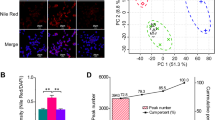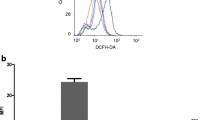Abstract
Nitro-fatty acids possess anti-atherogenic properties, but their effects on macrophage oxidative status and lipid metabolism that play important roles in atherosclerosis development are unclear. This study compared the effects of nitro-oleic acid (OLA-NO2) with those of native oleic acid (OLA) on intracellular reactive oxygen species (ROS) generation, anti-oxidants and metabolism of triglycerides and cholesterol in J774A.1 macrophages. Upon incubating the cells with physiological concentrations of OLA-NO2 (0–1 µM) or with equivalent levels of OLA, ROS levels measured by 2, 7-dichlorofluorescein diacetate, decreased dose-dependently, but the anti-oxidative effects of OLA-NO2 were significantly augmented. Copper ion addition increased ROS generation in OLA treated macrophages without affecting OLA-NO2 treated cells. These effects could be attributed to elevated glutathione levels and to increased activity and expression of paraoxonase2 that were observed in OLA-NO2 vs OLA treated cells. Beneficial effects on triglyceride metabolism were noted in OLA-NO2 vs OLA treated macrophages in which cellular triglycerides were reduced due to attenuated biosynthesis and accelerated hydrolysis of triglycerides. Accordingly, OLA-NO2 treated cells demonstrated down-regulation of diacylglycerol acyltransferase1, the key enzyme in triglyceride biosynthesis, and increased expression of hormone-sensitive lipase and adipose triglyceride lipase that regulate triglyceride hydrolysis. Finally, OLA-NO2 vs OLA treatment resulted in modest but significant beneficial effects on macrophage cholesterol metabolism, reducing cholesterol biosynthesis rate and low density lipoprotein influx into the cells, while increasing high density lipoprotein-mediated cholesterol efflux from the macrophages. Collectively, compared with OLA, OLA-NO2 modestly but significantly reduces macrophage oxidative status and cellular triglyceride content via modulation of cellular anti-oxidants and triglyceride metabolizing enzymes.






Similar content being viewed by others
Abbreviations
- AAPH :
-
2,2′-Amidinopropane hydrochloride
- ATGL:
-
Adipose triglyceride lipase
- DGAT1:
-
Diacylglycerol acyltransferase1
- HSL:
-
Hormone-sensitive lipase
- LPS:
-
Lipopolysaccharide
- MPM:
-
Mouse peritoneal macrophages
- Nrf2:
-
NF-E2-related factor2
- OLA:
-
Oleic acid
- OLA-NO2 :
-
Nitro-oleic acid
- PON2:
-
Paraoxonase2
- ROS:
-
Reactive oxygen species
References
Ross R (1999) Atherosclerosis—an inflammatory disease. N Engl J Med 340:115–126
Lusis AJ (2000) Atherosclerosis. Nature 407:233–241
Dickhout JG, Basseri S, Austin RC (2008) Macrophage function and its impact on atherosclerotic lesion composition, progression, and stability: the good, the bad, and the ugly. Arterioscler Thromb Vasc Biol 28:1413–1415
Moore KJ, Tabas I (2011) Macrophages in the pathogenesis of atherosclerosis. Cell 145:341–355
Rom O, Aviram M (2016) Endogenous or exogenous antioxidants vs. pro-oxidants in macrophage atherogenicity. Curr Opin Lipidol 27:204–206
Afonso Mda S, Castilho G, Lavrador MS, Passarelli M, Nakandakare ER, Lottenberg SA, Lottenberg AM (2014) The impact of dietary fatty acids on macrophage cholesterol homeostasis. J Nutr Biochem 25:95–103
Rapp JH, Lespine A, Hamilton RL, Colyvas N, Chaumeton AH, Tweedie-Hardman J, Kotite L, Kunitake ST, Havel RJ, Kane JP (1994) Triglyceride-rich lipoproteins isolated by selected-affinity anti-apolipoprotein B immunosorption from human atherosclerotic plaque. Arterioscler Thromb 14:1767–1774
Lundberg B (1985) Chemical composition and physical state of lipid deposits in atherosclerosis. Atherosclerosis 56:93–110
Ylä-Herttuala S, Lipton BA, Rosenfeld ME, Goldberg IJ, Steinberg D, Witztum JL (1991) Macrophages and smooth muscle cells express lipoprotein lipase in human and rabbit atherosclerotic lesions. Proc Natl Acad Sci USA 88:10143–10147
Rosenblat M, Aviram M (2009) Paraoxonases role in the prevention of cardiovascular diseases. Biofactors 35:98–104
Feingold KR, Shigenaga JK, Kazemi MR, McDonald CM, Patzek SM, Cross AS, Moser A, Grunfeld C (2012) Mechanisms of triglyceride accumulation in activated macrophages. J Leukoc Biol 92:829–839
Meilin E, Aviram M, Hayek T (2011) Insulin increases macrophage triglyceride accumulation under diabetic conditions through the down regulation of hormone sensitive lipase and adipose triglyceride lipase. Biofactors 37:95–103
Rosenblat M, Volkova N, Coleman R, Aviram M (2007) Anti-oxidant and anti-atherogenic properties of liposomal glutathione: studies in vitro, and in the atherosclerotic apolipoprotein E-deficient mice. Atherosclerosis 195:e61–e68
Rosenblat M, Draganov D, Watson CE, Bisgaier CL, La Du BN, Aviram M (2003) Mouse macrophage paraoxonase 2 activity is increased whereas cellular paraoxonase 3 activity is decreased under oxidative stress. Arterioscler Thromb Vasc Biol 23:468–474
Altenhöfer S, Witte I, Teiber JF, Wilgenbus P, Pautz A, Li H, Daiber A, Witan H, Clement AM, Förstermann U, Horke S (2010) One enzyme, two functions: PON2 prevents mitochondrial superoxide formation and apoptosis independent from its lactonase activity. J Biol Chem 285:24398–24403
Reddy ST, Devarajan A, Bourquard N, Shih D, Fogelman AM (2008) Is it just paraoxonase 1 or are other members of the paraoxonase gene family implicated in atherosclerosis? Curr Opin Lipidol 19:405–408
Baker PR, Schopfer FJ, O’Donnell VB, Freeman BA (2009) Convergence of nitric oxide and lipid signaling: anti-inflammatory nitro-fatty acids. Free Radic Biol Med 46:989–1003
Cui T, Schopfer FJ, Zhang J, Chen K, Ichikawa T, Baker PR, Batthyany C, Chacko BK, Feng X, Patel RP, Agarwal A, Freeman BA, Chen YE (2006) Nitrated fatty acids: endogenous anti-inflammatory signaling mediators. J Biol Chem 281:35686–35698
Tsikas D, Zoerner AA, Jordan J (2011) Oxidized and nitrated oleic acid in biological systems: analysis by GC-MS/MS and LC-MS/MS, and biological significance. Biochim Biophys Acta 1811:694–705
Baker PR, Lin Y, Schopfer FJ, Woodcock SR, Groeger AL, Batthyany C, Sweeney S, Long MH, Iles KE, Baker LM, Branchaud BP, Chen YE, Freeman BA (2005) Fatty acid transduction of nitric oxide signaling: multiple nitrated unsaturated fatty acid derivatives exist in human blood and urine and serve as endogenous peroxisome proliferator-activated receptor ligands. J Biol Chem 280:42464–42475
Freeman BA, Baker PR, Schopfer FJ, Woodcock SR, Napolitano A, d’Ischia M (2008) Nitro-fatty acid formation and signaling. J Biol Chem 283:15515–15519
Rudolph V, Freeman BA (2009) Cardiovascular consequences when nitric oxide and lipid signaling converge. Circ Res 105:511–522
Nadtochiy SM, Baker PR, Freeman BA, Brookes PS (2009) Mitochondrial nitroalkene formation and mild uncoupling in ischaemic preconditioning: implications for cardioprotection. Cardiovasc Res 82:333–340
Rudolph V, Rudolph TK, Schopfer FJ, Bonacci G, Woodcock SR, Cole MP, Baker PR, Ramani R, Freeman BA (2010) Endogenous generation and protective effects of nitro-fatty acids in a murine model of focal cardiac ischaemia and reperfusion. Cardiovasc Res 85:155–166
Zhang J, Villacorta L, Chang L, Fan Z, Hamblin M, Zhu T, Chen CS, Cole MP, Schopfer FJ, Deng CX, Garcia-Barrio MT, Feng YH, Freeman BA, Chen YE (2010) Nitro-oleic acid inhibits angiotensin II-induced hypertension. Circ Res 107:540–548
Charles RL, Rudyk O, Prysyazhna O, Kamynina A, Yang J, Morisseau C, Hammock BD, Freeman BA, Eaton P (2014) Protection from hypertension in mice by the Mediterranean diet is mediated by nitro fatty acid inhibition of soluble epoxide hydrolase. Proc Natl Acad Sci USA 111:8167–8172
Villacorta L, Chang L, Salvatore SR, Ichikawa T, Zhang J, Petrovic-Djergovic D, Jia L, Carlsen H, Schopfer FJ, Freeman BA, Chen YE (2013) Electrophilic nitro-fatty acids inhibit vascular inflammation by disrupting LPS-dependent TLR4 signalling in lipid rafts. Cardiovasc Res 98:116–124
Rudolph TK, Rudolph V, Edreira MM, Cole MP, Bonacci G, Schopfer FJ, Woodcock SR, Franek A, Pekarova M, Khoo NK, Hasty AH, Baldus S, Freeman BA (2010) Nitro-fatty acids reduce atherosclerosis in apolipoprotein E-deficient mice. Arterioscler Thromb Vasc Biol 30:938–945
Rudolph TK, Freeman BA (2009) Transduction of redox signaling by electrophile-protein reactions. Sci Signal 2:re7
Villacorta L, Zhang J, Garcia-Barrio MT, Chen XL, Freeman BA, Chen YE, Cui T (2007) Nitro-linoleic acid inhibits vascular smooth muscle cell proliferation via the Keap1/Nrf2 signaling pathway. Am J Physiol Heart Circ Physiol 293:H770–H776
Kansanen E, Jyrkkänen HK, Volger OL, Leinonen H, Kivelä AM, Häkkinen SK, Woodcock SR, Schopfer FJ, Horrevoets AJ, Ylä-Herttuala S, Freeman BA, Levonen AL (2009) Nrf2-dependent and -independent responses to nitro-fatty acids in human endothelial cells: identification of heat shock response as the major pathway activated by nitro-oleic acid. J Biol Chem 284:33233–33241
Aviram M (1983) Plasma lipoprotein separation by discontinuous density gradient ultracentrifugation in hyperlipoproteinemic patients. Biochem Med 30:111–118
Lowry OH, Rosebrough NJ, Farr AL, Randall RJ (1951) Protein measurement with the Folin phenol reagent. J Biol Chem 193:265–275
LeBel CP, Ischiropoulos H, Bondy SC (1992) Evaluation of the probe 2′,7′-dichlorofluorescein as an indicator of reactive oxygen species formation and oxidative stress. Chem Res Toxicol 5:227–231
Valko M, Rhodes CJ, Moncol J, Izakovic M, Mazur M (2006) Free radicals, metals and antioxidants in oxidative stress-induced cancer. Chem Biol Interact 160:1–40
Fuhrman B, Oiknine J, Aviram M (1994) Iron induces lipid peroxidation in cultured macrophages, increases their ability to oxidatively modify LDL, and affects their secretory properties. Atherosclerosis 111:65–78
Ramirez DC, Mejiba SE, Mason RP (2005) Copper-catalyzed protein oxidation and its modulation by carbon dioxide: enhancement of protein radicals in cells. J Biol Chem 280:27402–27411
Tietze F (1969) Enzymic method for quantitative determination of nanogram amounts of total and oxidized glutathione: applications to mammalian blood and other tissues. Anal Biochem 27:502–522
Gaidukov L, Tawfik DS (2005) High affinity, stability, and lactonase activity of serum paraoxonase PON1 anchored on HDL with ApoA-I. Biochemistry 44:11843–11854
Miyoshi H, Perfield JW 2nd, Obin MS, Greenberg AS (2008) Adipose triglyceride lipase regulates basal lipolysis and lipid droplet size in adipocytes. J Cell Biochem 105:1430–1436
Frémont L, Belguendouz L, Delpal S (1999) Antioxidant activity of resveratrol and alcohol-free wine polyphenols related to LDL oxidation and polyunsaturated fatty acids. Life Sci 64:2511–2521
Meilin E, Aviram M, Hayek T (2011) Insulin increases macrophage triglyceride accumulation under diabetic conditions through the down regulation of hormone sensitive lipase and adipose triglyceride lipase. Biofactors 37:95–103
Yang X, Yao H, Chen Y, Sun L, Li Y, Ma X, Duan S, Li X, Xiang R, Han J, Duan Y (2015) Inhibition of glutathione production induces macrophage CD36 expression and enhances cellular-oxidized low density lipoprotein (oxLDL) uptake. J Biol Chem 290:21788–21799
Rosenblat M, Coleman R, Reddy ST, Aviram M (2009) Paraoxonase 2 attenuates macrophage triglyceride accumulation via inhibition of diacylglycerol acyltransferase 1. J Lipid Res 50:870–879
Rom O, Volkova N, Nandi S, Jelinek R, Aviram M (2016) Pomegranate juice polyphenols induce macrophage death via apoptosis as oppose to necrosis induced by free radical generation: a central role for oxidative stress. J Cardiovasc Pharmacol. doi:10.1097/FJC.0000000000000391
Petrick L, Rosenblat M, Paland N, Aviram M (2016) Silicon dioxide nanoparticles increase macrophage atherogenicity: stimulation of cellular cytotoxicity, oxidative stress, and triglycerides accumulation. Environ Toxicol 31:713–723
Rom O, Aviram M (2016) Paraoxsonase2 (PON2) and oxidative stress involvement in pomegranate juice protection against cigarette smoke-induced macrophage cholesterol accumulation. Chem Biol Interact. doi:10.1016/j.cbi.2016.05.009 (in press)
Rosenblat M, Aviram M (2011) Pomegranate juice protects macrophages from triglyceride accumulation: inhibitory effect on DGAT1 activity and on triglyceride biosynthesis. Ann Nutr Metab 58:1–9
Ambrozova G, Martiskova H, Koudelka A, Ravekes T, Rudolph TK, Klinke A, Rudolph V, Freeman BA, Woodcock SR, Kubala L, Pekarova M (2016) Nitro-oleic acid modulates classical and regulatory activation of macrophages and their involvement in pro-fibrotic responses. Free Radic Biol Med 90:252–260
Koenitzer JR, Bonacci G, Woodcock SR, Chen CS, Cantu-Medellin N, Kelley EE, Schopfer FJ (2015) Fatty acid nitroalkenes induce resistance to ischemic cardiac injury by modulating mitochondrial respiration at complex II. Redox Biol 8:1–10
Yen CL, Stone SJ, Koliwad S, Harris C, Farese RV Jr (2008) Thematic review series: glycerolipids. DGAT enzymes and triacylglycerol biosynthesis. J Lipid Res 49:2283–22301
Meilin E, Aviram M, Hayek T (2010) Paraoxonase 2 (PON2) decreases high glucose-induced macrophage triglycerides (TG) accumulation, via inhibition of NADPH-oxidase and DGAT1 activity: studies in PON2-deficient mice. Atherosclerosis 208:390–395
Aronis A, Madar Z, Tirosh O (2005) Mechanism underlying oxidative stress-mediated lipotoxicity: exposure of J774.2 macrophages to triacylglycerols facilitates mitochondrial reactive oxygen species production and cellular necrosis. Free Radic Biol Med 38:1221–1230
Acknowledgments
This study was supported by grants from the Technion Rappaport Institute for Research in the Medical Sciences, Bio Rap Technologies, the Clinical Research Institute at Rambam (CRIR) and the Michigan-Israel Partnership Research Grant.
Author information
Authors and Affiliations
Corresponding author
Ethics declarations
Conflict of interest
The authors declare that they have no conflict of interest.
About this article
Cite this article
Rosenblat, M., Rom, O., Volkova, N. et al. Nitro-Oleic Acid Reduces J774A.1 Macrophage Oxidative Status and Triglyceride Mass: Involvement of Paraoxonase2 and Triglyceride Metabolizing Enzymes. Lipids 51, 941–953 (2016). https://doi.org/10.1007/s11745-016-4169-2
Received:
Accepted:
Published:
Issue Date:
DOI: https://doi.org/10.1007/s11745-016-4169-2




